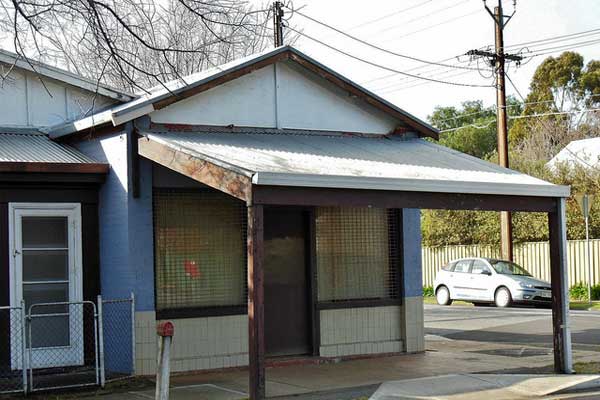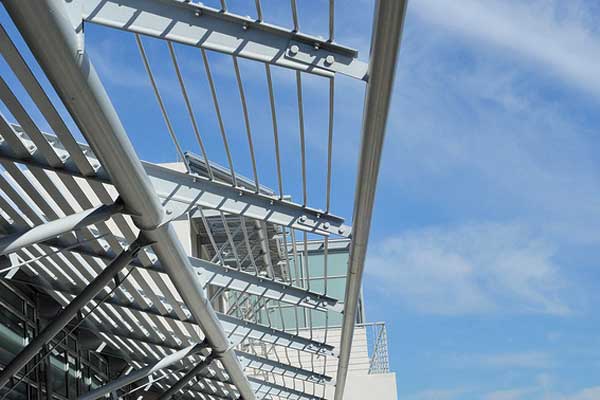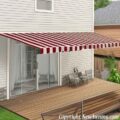Last Updated:July 09, 2025
Louver Roof Awnings – Everything you ever wanted to know.
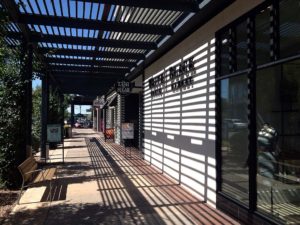
This is one of our favorite types of awning because of its versatility and beauty. The frame either has two vertical supports with one side attached to the house or four free standing vertical supports to make it movable.
Unlike other models of retractable awnings, the frame, size, and shape are all fixed. There is a large wooden or aluminum rectangle frame at the top of the supports. The frame remains in place, and between each side rail of the frame will be a joist or louver.
What are Louver Roof Awnings?
If you’re not familiar then you could imagine a Venetian shade placed horizontally in a wooden frame. The joists between the two sides of the frame create a allow some of the light to pass through, but also provide considerable shade. Most of the models feature fixed position joists that are always perpendicular to the ground. These are incredibly popular in upscale locations in the Southwest such as California and Arizona. We also found an amazing video on YouTube created by Arcadia Louvered Roof System. .We aren’t affiliated with the company who created the video, and are simply including this because they have done an amazing job at explaining the the features and functionality.
Due to the popularity of the fixed louver awning, a couple of very creative companies have created a mechanism that allows the louver to rotate in a similar manner to how the Venetian blinds mentioned above operate. These have built-in gutter systems so they can be open for sunny days, and be closed for rainy days so that space is always usable. These get the best of both worlds as you get the beauty of the open roof awnings while being able to use the patio all the time.
What Type of Materials are used in this?
They can be divided into two categories. The first are the wooden models that use treated lumber as the support legs, frame, and the louvers. Most of the time these are custom built pieces that begin as lumber which is cut specially for a custom designed awning or gazebo. There are some companies that make wood kits with all the pieces cut so they can be easily assembled; however, this makes up a far smaller portion of the wooden awnings. The second group is the structures that are composed of metal. The support posts and rafters are composed of a stainless or galvanized steel, and the joists are made of a lightweight extruded aluminum. The metal awnings are typically sold as kits, and they can be installed by someone with moderate home improvement abilities. This is usually a two person job simply due to the need of a second pair of hands to position all the parts during construction.Depending on your budget there are two types of louvers. The first is a traditional rectangular shaped hollow beam that measures about 2″ x 5″. The beam is placed so the 2″ is horizontal and the 5″ is vertical so that when the sun is at an angle the joists overlap to create a contiguous area of shade. The second style of awning is a fluted louver has a cross section closer to the shape of the letter “S”. The fluted variation will provide just as much shading as the hollow beam, and it allows for improved airflow.
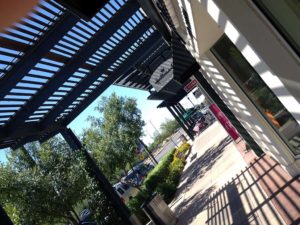
Why Get This Style of Awning?
Wood patio covers are more aesthetic than functional in our opinion. They are incredibly popular for homeowners because of their beauty, and they lend themselves to having many different layouts. The cost of the wood patio cover will depend entirely on the type of wood selected. There will be a huge difference in price of pine which will be $5.31 for a 2″x4″x 8′ compared with cherry which has a single board cost of $64.96. Regardless of the type of tree you select, you will always want it to be fully treated to prevent weather damage. One of our experts is working on a guide that will help homeowners identify the lower cost wood and stain it to appear as a higher value wood.The primary advantage of the wood covers is the wow factor because when they are built correctly will be beautiful, and it can completely transform the exterior of the home. These can also be created by a skilled DIY craftsman. The drawbacks are the financial costs because these are the most expensive on our list, and additionally, they also require ongoing maintenance. In the rural areas, the frame can become the home to birds or bees which build nests that can damage the structure.
Drawbacks of this Style?

The main drawback to this option is the price. Whether it’s an attached awning or standalone gazebo, louver roof structures have a higher price tag than a closed roof option of a similar size. The primary driver for this is material cost as the fabric awnings only have support posts and rafters made of wood or metal with the shade being created by the lower cost fabric. For reference, a louvered roof awning kit can be triple the price of a very high-quality fabric based retractable awning kit. Additionally, the labor costs for the fabric option are also considerably less which is the only drawback that our team has with the louver style of structure.
Frequently Asked Questions on Awnings with a Louver Roof
Below we have compiled a list of the most common questions we see on this topic. If you would like to know something that is not covered on this page, please feel free to send us either an email or post in a comment below. While we certainly don’t know everything on the topic, we are happy to share the information we have learned.-
Do you need a building permit for a louvered roof pergola or awning?
This depends on your area. In some areas of Florida, there are requirements on the amount of the wind that the structure must be able to withstand. In some areas in midwest states, there are requirements around the amount of snow that it must be able to support. Because the United States is a large country, the local regulations are going to vary. Because this is a major investment, we recommend that you contact a local awning company to inquire about restrictions. Even if you choose to do a DIY project, you may want to consult with them to get you through the licensing portion. -
How do you clean the louvered roofing?
This style is far easier to clean than the traditional retractable awning. The first step is to use a garden hose to spray a generous amount of water over the entire surface. Pay special attention to the underside of the slats, as they are both the closest to the ground and least likely to be rinsed via rainwater. Let the structure sit for 5 minutes so that the moisture has some time to absorb.
Next, you will want to make a bucket of cleaning liquid, and we recommend following the instructions by the specific manufacturer. If this is a DIY project, then you should look up the best cleaning options for the specific material you used whether that is wood or aluminum. From there, take a long handled brush and let is soak in the bucket for about 15 seconds so the bristles are fully covered with the soap. With the brush, you will want to wash each rafter individually. Start first by carefully rubbing the underside and then on each of the sides. After you finish cleaning all the rafters, you will then want to spray the entire awning with a substantial drenching from the house. For most areas, this is something that only needs to be done once or twice per year. -
Will a louvered roof awning keep my house cooler?
Absolutely! This can keep your outdoor deck or patio up to 20 degrees cooler, and it can also lower your internal cooling bill by limiting the amount of sunlight that goes through the patio windows or doors. They have also been shown to lower the carbon footprint of the home. -
Do these work with solar energy systems?
If you are considering a solar panel system, then we highly recommend choosing a different model. Technically, they can work by attaching them to the top of the rafters and leaving some space; however, their cooling impact will be greatly diminished as the panels will disrupt the airflow. -
Can I leave this up year round??
Absolutely! One of the major perks is that the open roof design will allow rain and most snow to fall through. We do recommend clearing it off with your cleaning if any snow accumulation occurs as many times the rafters are not designed to support the additional mass from the snow. -
Any methods of lowering the impact of corrosion or weather damage?
If your area receives a lot of precipitation, there is a silicone sealant that can be applied over the joints. This will create a water tight seal to stop anything from seeping in the connections that would eventually cause damage. The silicone awning sealant is rather in expensive at less than $15 per quart can. -
Any methods of lowering the impact of corrosion or weather damage?
Yes, we find them beautiful, and we considered adding a fourth type to this page. We ultimately decided to omit them because we wanted to keep the guide more user-friendly, and we believed that topic was a tad more advanced than we wanted to cover in this post. -
How long should the louver roof awning last?
With proper maintenance, it can easily last for more than a decade. Simple common sense cleaning and routine upkeep will keep it in good working order.


